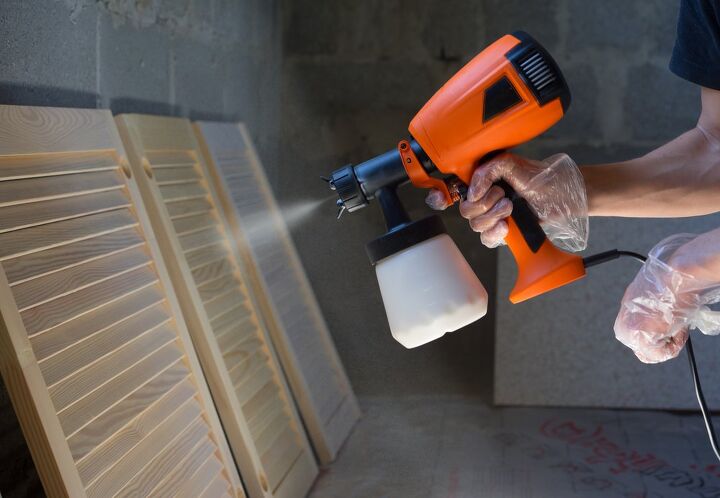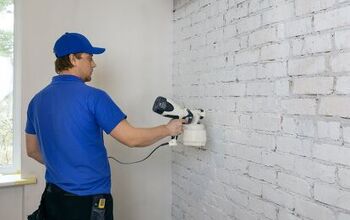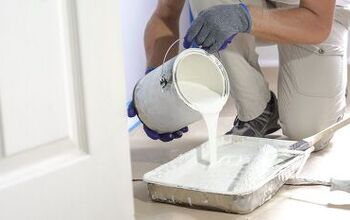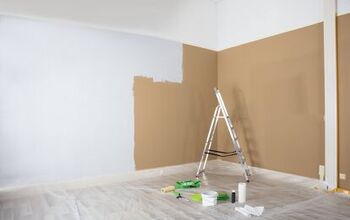What Is An HVLP Paint Sprayer? (Find Out Now!)

You want all of your projects to turn out great. But you don’t want to spend too much time on the paint. So, use an HVLP sprayer to shorten your wait time. Then choose the best colors to enjoy a flawless finish.
An HVLP sprayer is a standard tool that painters use to cover surfaces quickly. The sprayer uses a combination of pressure and air to spread color on the target. However, you can’t use an HVLP sprayer for precision painting. That’s because it sends out a high volume of air and paint, which can be challenging to control.
Do You Need to Hire a Paint Contractor?
Get free, zero-commitment quotes from pro contractors near you.

What Does HVLP Stand For?
The acronym HVLP stands for High Volume Low Pressure. And the title describes how it works. First, gears inside the motor draw high volumes of air into a chamber. Then, you pull a trigger to spray it through the nozzle at low pressure.
Because of the innovative design, HVLP paint spray guns are some of the most efficient on the market. They help to preserve resources by wasting less paint. You also get fewer brush strokes and imperfections. That means lower renovation costs and decreased supply consumption.
DID YOU KNOW: Some people call high-volume low-pressure guns “turbo sprayers.”
What Are HVLP Paint Sprayers Used For?
High-Volume Low-Pressure paint sprayers are perfect for contractors and homeowners. You can use them for professional renovations as well as DIY projects. Meanwhile, here are some of the most popular uses for HVLP painters:
- Applying Primer
- Painting Trim
- Finish Work
- Staining Furniture
- Covering Cabinetry
You’ll also find these sprayers anywhere that detail work is required. And a high-pressure, low-volume gun is always best for projects that call for accuracy and speed with a smooth finish.
What Is the Difference Between HVLP and Airless Sprayers?
An HVLP painter uses a compressor to generate power, and an airless sprayer does not. Instead, airless machines use pressurized pumps and pistons to push paint through the line. There, the liquid passes through a tiny hole to become atomized. And High Volume Low-Pressure devices depend on turbines to atomize the paint.
NOTE: You can buy devices with different levels of spraying power.
Is HVLP Better Than Spray Paint?
Some ask whether HVLP is better than spray paint, and it is. That’s because spray paint comes out of the can at a wider angle. Plus, you don’t get as much pressure behind the trigger. And you don’t have as much control over the contents. Also, you can’t cover as much surface area, and it will take you longer to finish as a result.
High-Volume devices are nearly twice as efficient. They help you paint about 70% of the material in a single pass. However, the high cost of an HVLP sprayer may absorb what you save in time and money. Expect to pay around $200 for a new machine. Meanwhile, spray paint costs only a few dollars per can.
Do HVLP Paint Sprayers Need an Air Compressor?
Yes, you need an air compressor to use an HVLP paint spraying gun. The reason is that High-Volume, Low-Pressure devices use electricity to generate airflow. So, you won’t get enough power unless you hook it to a compressor. Plus, your compressor must be powerful enough to handle it.
If you don’t have an air compressor, you can use a turbine-powered spray gun instead. Turbine guns can finish the job without a compressor because they use different mechanics. Either way, both options are better than spray paint in a can.
NOTE: The thicker your paint, the more power you’ll need to spray it from the nozzle.
How Do You Thin Oil-Based Paint for an HVLP Spray Gun?
Depending on the color you use, you might have to thin oil-based paint to use a low-pressure sprayer. In that case, this is what you should do:
Step 1: Pick and Strain Your Color
Choose a paint color and pour the contents of the can through a strainer. That way, you remove any debris that’s floating in the liquid.
Step 2: Add Some Paint Thinner
Choose mineral spirits or turpentine to thin oil-based colors. And always mind the 3:1 rule.
Step 3: Stir Thoroughly to Mix
Do not shake your paint. Mix it with a mixer or paint stick instead. Gentle mixing helps blend the contents to prevent caking.
Step 4: Strain It Again
Run your strained and thinned color through a funnel into your sprayer’s empty paint chamber.
Remember, oily paint can stain carpets and fabrics. So, try to do this work outside or in the garage. And if you make a mess with your colors, clean it up quickly before the paint sets.
TIP: You usually have about two hours before your paint becomes tacky or dries.
Do You Thin Water-Based Paint for a Spray Gun?
You can thin out watery paint for your sprayer as well. First, add a small amount of water and mix it thoroughly. Then, add more as needed to reach the correct consistency. Remember that it’s much easier to pour moisture in than take it back out.
Related Questions
Can You Run Paint Thinner Through a Sprayer?
You can put paint thinner in a spray gun without damaging the components. It’s a good practice between projects to maintain your machines. Most thinning agents are mechanically safe. And that means you can use them to dislodge dried flakes and debris from the lines. However, be sure to wash the tubes afterward. Leaving paint thinner in plastic can damage your device.
What PSI Is Needed for Spray Painting?
If using a sprayer, set your compressor to 25-30 PSI. And determine the pressure level by pulling the trigger on your empty paint gun. Look at the dial to ensure it falls within the correct range. After that, adjust the PSI to suit your paint type and desired speed.
Can You Spray Paint with HVLP?
You need plenty of air for your High-Volume Low-Pressure paint sprayer. That means you have to hook up a great air compressor to it. The one in your garage will probably work. But first, check the specifications to be sure. Powerful sprayers may require more juice to spread the colors evenly.
Spray a range of different liquids with a three-horsepower compressor. And make sure it features a 20-gallon (75 liter) air tank. You can read the label to find more information about your industrial appliances. But don’t forget to check your breaker because it may not be strong enough to run both machines simultaneously.
Do You Need to Hire a Paint Contractor?
Get free, zero-commitment quotes from pro contractors near you.

Use HVLP to HELP
An HVLP paint sprayer can help make creative projects easier. But you must maintain the machine and clear the lines. So, clean paint sprayers after each project to prevent build-up and damage.
Related Guides
Spraying Deck Paint vs. Rolling: What Are The Major Differences?
What Is The Best Paint To Hide Imperfections?
2022 Cost To Paint Kitchen Cabinets
How Long After Painting A Room Is It Safe?
Air Compressor Won’t Build Pressure? (Possible Causes & Fixes)

Tiffany Nichols specializes in aesthetics, design, marketing, and manufacturing. She's a copywriter and editor for several home renovation companies in the U.S. and works alongside some of the biggest names in the industry. Her hobbies include architecture, art, mental health, and fashion.
More by Tiffany Nichols



























